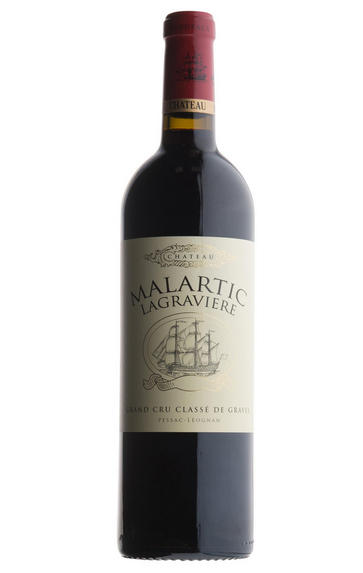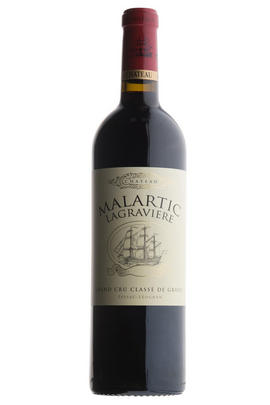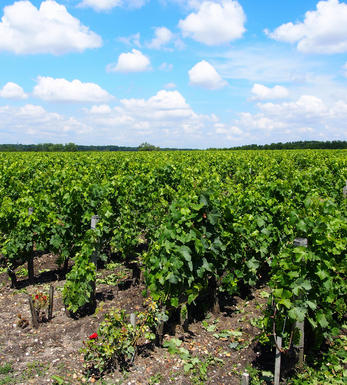
2015 Château Malartic-Lagravière, Pessac-Léognan, Bordeaux

Critics reviews
Lisa Perrotti-Brown - 21/02/2018
Drink 2025-2040
Jancis Robinson MW - jancisrobinson.com - Apr 2016
James Suckling - jamessuckling.com - Apr 2016
Drink: 2025-2038
Jane Anson - decanter.com - April 2016
About this WINE

Chateau Malartic Lagraviere
Château Malartic-Lagravière, a Cru Classé de Graves,was previously owned by the Champagne house, Laurent- Perrier - in 1997 it was bought by a Belgian couple, Michele and Alfred-Alexandre Bonnie, whose son and daughter-in-law, Jean-Jacques and Severine, have now assumed control.
There are 47 hectares of under vine, but only 7 of which are dedicated to white grapes, situated on a fine gravel ridge and now almost encroached on by the suburban outgrowth of Léognan. The estate produces high quality reds as well as tiny amounts of Sauvignon Blanc-dominated white wine. The red is a blend of 50% Cabernet Sauvignon, 25% Merlot and 25% Cabernet Franc.
The grapes are fermented partly in wooden vats, partly in stainless steel tanks, and then spend up to 15 months in oak barrels, roughly 50% of which are new. The creation of a second wine, La Réserve de Malartic Rouge (previously known as Le Sillage de Malartic), has been a further aid to the qualitative improvement which has been steadily taking place here over the past decade or so. In recent years no more than 60% of the crop goes into the Grand Vin, far less than back in the early 1990s and testament to the dedication to the highest levels of quality displayed by the new owners.
Their red wines are discreetly elegant, well-balanced that can be austere in youth but, with age, develop complexity and a distinct mineral character that is shared by all the great clarets of Pessac-Léognan.

Pessac-Leognan
In 1986 a new communal district was created within Graves, in Bordeaux, based on the districts of Pessac and Léognan, the first of which lies within the suburbs of the city. Essentially this came about through pressure from Pessac-Léognan vignerons, who wished to disassociate themselves from growers with predominately sandy soils further south in Graves.
Pessac-Léognan has the best soils of the region, very similar to those of the Médoc, although the depth of gravel is more variable, and contains all the classed growths of the region. Some of its great names, including Ch. Haut-Brion, even sit serenely and resolutely in Bordeaux's southern urban sprawl.
The climate is milder than to the north of the city and the harvest can occur up to two weeks earlier. This gives the best wines a heady, rich and almost savoury character, laced with notes of tobacco, spice and leather. Further south, the soil is sandier with more clay, and the wines are lighter, fruity and suitable for earlier drinking.
Recommended Châteaux: Ch. Haut-Brion, Ch. la Mission Haut-Brion, Ch. Pape Clément, Ch Haut-Bailly, Domaine de Chevalier, Ch. Larrivet-Haut-Brion, Ch. Carmes Haut-Brion, Ch. La Garde, Villa Bel-Air.

Cabernet Sauvignon Blend
Cabernet Sauvignon lends itself particularly well in blends with Merlot. This is actually the archetypal Bordeaux blend, though in different proportions in the sub-regions and sometimes topped up with Cabernet Franc, Malbec, and Petit Verdot.
In the Médoc and Graves the percentage of Cabernet Sauvignon in the blend can range from 95% (Mouton-Rothschild) to as low as 40%. It is particularly suited to the dry, warm, free- draining, gravel-rich soils and is responsible for the redolent cassis characteristics as well as the depth of colour, tannic structure and pronounced acidity of Médoc wines. However 100% Cabernet Sauvignon wines can be slightly hollow-tasting in the middle palate and Merlot with its generous, fleshy fruit flavours acts as a perfect foil by filling in this cavity.
In St-Emilion and Pomerol, the blends are Merlot dominated as Cabernet Sauvignon can struggle to ripen there - when it is included, it adds structure and body to the wine. Sassicaia is the most famous Bordeaux blend in Italy and has spawned many imitations, whereby the blend is now firmly established in the New World and particularly in California and Australia.


Buying options
Add to wishlist
Description
Offering a dense, opulent style, this is an ambitious effort. Glowing deep crimson at its core, with a lighter purple rim, it is a modern style of Pessac-Léognan, which fits perfectly into the style of the 2015 vintage. More obviously fruity than one might expect of the appellation, it is ripe, with delicious blackberry on the nose and palate. Soft, integrated tannins and a lush, opulent finish complete the picture.
wine at a glance
Delivery and quality guarantee